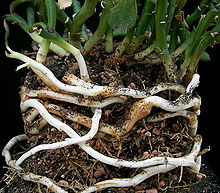
In botany and dendrology, a rhizome (/ˈraɪzoʊm/ RY-zohm) is a modified subterranean plant stem that sends out roots and shoots from its nodes. Rhizomes are also called creeping rootstalks or just rootstalks. Rhizomes develop from axillary buds and grow horizontally. The rhizome also retains the ability to allow new shoots to grow upwards.
A rhizome is the main stem of the plant that runs typically underground and horizontally to the soil surface. Rhizomes have nodes and internodes and auxiliary buds. Roots do not have nodes and internodes and have a root cap terminating their ends. In general, rhizomes have short internodes, send out roots from the bottom of the nodes, and generate new upward-growing shoots from the top of the nodes. A stolon is similar to a rhizome, but stolon sprouts from an existing stem having long internodes and generating new shoots at the ends, they are often also called runners such as in the strawberry plant.

A stem tuber is a thickened part of a rhizome or stolon that has been enlarged for use as a storage organ. In general, a tuber is high in starch, e.g. the potato, which is a modified stolon. The term "tuber" is often used imprecisely and is sometimes applied to plants with rhizomes.
The plant uses the rhizome to store starches, proteins, and other nutrients. These nutrients become useful for the plant when new shoots must be formed or when the plant dies back for the winter. If a rhizome is separated, each piece may be able to give rise to a new plant. This is a process known as vegetative reproduction and is used by farmers and gardeners to propagate certain plants. This also allows for lateral spread of grasses like bamboo and bunch grasses. Examples of plants that are propagated this way include hops, asparagus, ginger, irises, lily of the valley, cannas, and sympodial orchids.
Stored rhizomes are subject to bacterial and fungal infections, making them unsuitable for replanting and greatly diminishing stocks. However, rhizomes can also be produced artificially from tissue cultures. The ability to easily grow rhizomes from tissue cultures leads to better stocks for replanting and greater yields. The plant hormones ethylene and jasmonic acid have been found to help induce and regulate the growth of rhizomes, specifically in rhubarb. Ethylene that was applied externally was found to affect internal ethylene levels, allowing easy manipulations of ethylene concentrations. Knowledge of how to use these hormones to induce rhizome growth could help farmers and biologists to produce plants grown from rhizomes, and more easily cultivate and grow better plants.
Some plants have rhizomes that grow above ground or that lie at the soil surface, including some Iris species as well as ferns, whose spreading stems are rhizomes. Plants with underground rhizomes include gingers, bamboo, snake plant, the Venus flytrap, Chinese lantern, western poison-oak, hops, and Alstroemeria, and some grasses, such as Johnson grass, Bermuda grass, and purple nut sedge. Rhizomes generally form a single layer, but in giant horsetails, can be multi-tiered.

Many rhizomes have culinary value, and some, such as zhe'ergen, are commonly consumed raw. Some rhizomes that are used directly in cooking include ginger, turmeric, galangal, fingerroot, and lotus.
See also
Explanatory notes
- from Ancient Greek ῥίζωμα (rhízōma) 'mass of roots', from ῥιζόω (rhizóō) 'cause to strike root'
References
- ῥίζωμα. Liddell, Henry George; Scott, Robert; A Greek–English Lexicon at the Perseus Project
- ῥιζόω
- "rhizome | Description, Functions, & Examples". Encyclopedia Britannica. Retrieved 15 June 2021.
- ^ Jang, Cheol Seong; et al. (2006). "Functional classification, genomic organization, putatively cis-acting regulatory elements, and relationship to quantitative trait loci, of sorghum genes with rhizome-enriched expression". Plant Physiology. 142 (3): 1148–1159. doi:10.1104/pp.106.082891. PMC 1630734. PMID 16998090.
- Wilford, Richard; Gardens, Kew Royal Botanic (3 September 2019). The Kew Gardener's Guide to Growing Bulbs: The art and science to grow your own bulbs. Frances Lincoln. ISBN 978-0-7112-4717-8.
- Clarke, Richard L. W. (2000). "Root Versus Rhizome: An 'Epistemological Break' in Francophone Caribbean Thought". Journal of West Indian Literature. 9 (1): 12–41. ISSN 0258-8501. JSTOR 23019767.
- Davis, Tim D.; Haissig, Bruce E. (11 November 2013). Biology of Adventitious Root Formation. Springer Science & Business Media. ISBN 978-1-4757-9492-2.
- B.P, Pandey. Botany for B.Sc. Students Semester I: Introduction to Microbes and Plant Kingdom (NEP 2020 -Jammu). S. Chand Publishing. ISBN 978-93-5501-270-8.
- Kraehmer, Hansjoerg; Hesse, Linnea (29 July 2024). Rhizomes: Hidden Stems with Unknown Diversity. John Wiley & Sons. ISBN 978-1-119-82714-6.
- Stern, Kingsley R. (2002). Introductory Plant Biology (10th ed.). McGraw Hill. ISBN 0-07-290941-2.
- Nayak, Sanghamitra; Naik, Pradeep Kumar (2006). "Factors effecting in vitro microrhizome formation and growth in Curcuma longa L. and improved field performance of micropropagated plants". Science Asia. 32: 31–37. doi:10.2306/scienceasia1513-1874.2006.32.031.
- Rayirath, Usha P; et al. (2011). "Role of ethylene and jasmonic acid on rhizome induction and growth in rhubarb (Rheum rhabarbarum L.)". Plant Cell, Tissue and Organ Culture. 105 (2): 253–263. doi:10.1007/s11240-010-9861-y. S2CID 6630060.
- Hogan, C. Michael (2008). Stromberg, Nicklas (ed.). "Western Poison-oak (Toxicodendron diversilobum)". GlobalTwitcher. Archived from the original on 21 July 2009.
- Husby, C. (2003). "Ecology and Physiology of the Giant Horsetails". Florida International University. Archived from the original on 14 July 2009.
- Lim, T.K. (2016). Edible Medicinal and Non-Medicinal Plants (11th ed.). Springer. ISBN 978-3-319-26061-7.
- "Ginger | plant". Encyclopedia Britannica. Retrieved 15 December 2020.
- "turmeric | Description, History, & Uses". Encyclopedia Britannica. Retrieved 15 December 2020.
- "Chinese Ginger. Alpinia Galanga, Willd". Bulletin of Miscellaneous Information (Royal Botanic Gardens, Kew). 1891 (49): 5–9. 1891. doi:10.2307/4114957. ISSN 0366-4457. JSTOR 4114957.
External links
 Media related to Rhizomes at Wikimedia Commons
Media related to Rhizomes at Wikimedia Commons
| Botany | |||||||||||
|---|---|---|---|---|---|---|---|---|---|---|---|
| Subdisciplines | |||||||||||
| Plant groups | |||||||||||
| Plant anatomy |
| ||||||||||
| Plant physiology Materials | |||||||||||
| Plant growth and habit | |||||||||||
| Reproduction | |||||||||||
| Plant taxonomy | |||||||||||
| Practice | |||||||||||
| |||||||||||